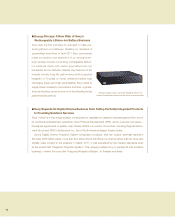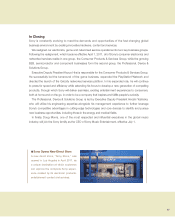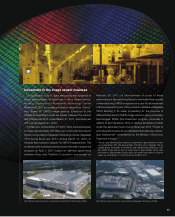Sony 2011 Annual Report Download - page 25
Download and view the complete annual report
Please find page 25 of the 2011 Sony annual report below. You can navigate through the pages in the report by either clicking on the pages listed below, or by using the keyword search tool below to find specific information within the annual report.
23
16.38 effective megapixels back-illuminated CMOS image sensor
for compact digital cameras
year ended March 31, 2010), Sony has also achieved the top
market share for CMOS image sensors, based on sales value.*
Sony intends to continue aggressively expanding its “Exmor R”
back-illuminated CMOS image sensor business and thereby
contribute to the realization of further advances in resolution in
consumer-use digital video cameras and digital still cameras.
■Interview with Teruo Hirayama, Senior
G e n e r a l M a n a g e r, S e m i c o n d u c t o r
Tec hn o l o gy De ve l o p me n t Di v is io n ,
Semiconductor Business Group
Until quite recently, although CMOS image sensors enjoyed
the advantage of comparatively low power consumption,
their structural weak point was a high level of noise, making
them unsuitable for use in high-quality digital cameras. For
this reason they were almost solely used in such devices
as mobile phones. Although we knew that it would be
possible to increase image quality by utilizing a back-
illuminated structure to capture light more efficiently, the
stumbling block we faced was an increase in noise.
Consequently, most image sensor specialists believed that
it was almost impossible to develop an image sensor based
on such a structure.
In 2002, when I transferred from my previous job
developing MOS logic and was assigned to the project team
for image sensor development—an area outside my direct
expertise—this was still the prevailing view among image
sensor design engineers. When we began the project to
develop an “Exmor R” back-illuminated CMOS image sensor,
there were fewer than 10 of us on the project team. While
we believed that our success could usher in a major change
in the world of imaging technology, we spent a considerable
period struggling to overcome the noise issue.
However, through ongoing trial and error, we came up
with an idea that we thought might be the solution. Straight
away, we asked the opinion of a Sony Handycam® video
camera developer, who was startled by the exquisite image
quality we showed him. The high quality of the images we
shot, even in dimly lit settings, was unprecedented at the
time. We received a directive to rapidly commercialize the
technology and, as soon as we overcame issues relating to
mass production, succeeded in commercializing the world’s
first consumer-use products to incorporate “Exmor R” back-
illuminated CMOS image sensor technology.
Even during the period in which we struggled to overcome
technical difficulties, the “Sony Spirit” kept us determined not
to give in but to rise to the challenge, in the end leading to the
creation of new technology. Even now, Sony’s “Exmor R” back-
illuminated CMOS image sensors have a clear competitive
advantage. There is still ample room to improve the image
quality and performance of image sensor technology, so
we will not be resting on
our laurels. We are
committed to continuing
our development efforts
so that we can realize
further advances in
technology that will
bring enjoyment and
excitement to our
customers.
























